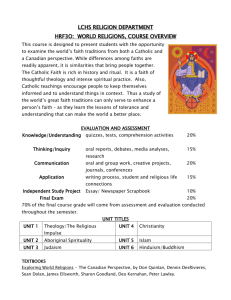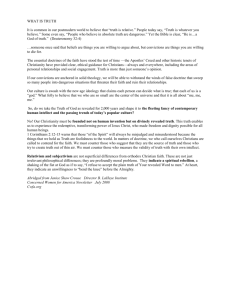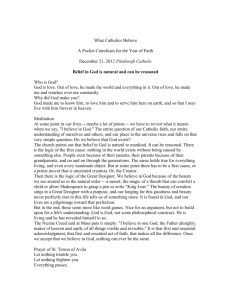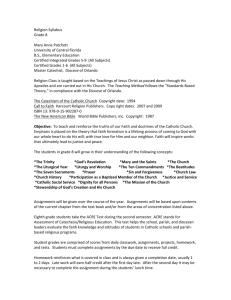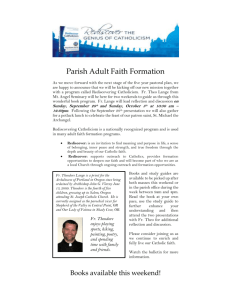File - Religious Studies 303
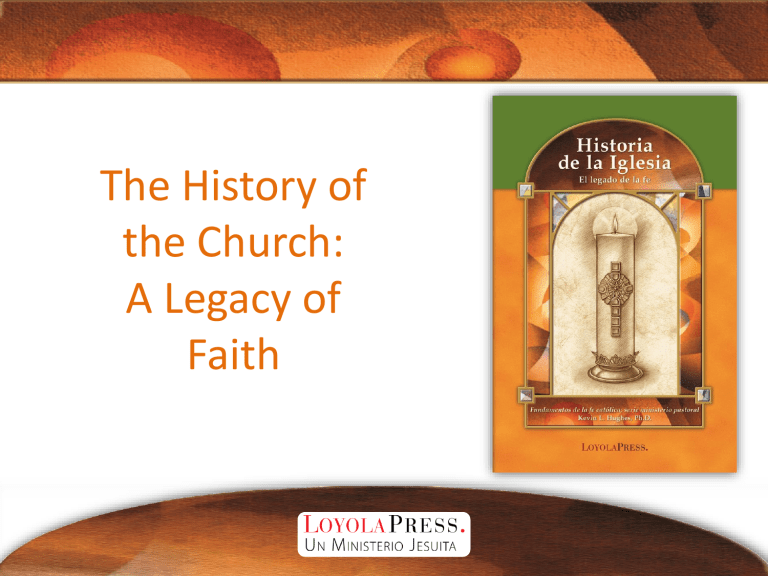
The History of the Church:
A Legacy of
Faith
Introduction
• There is history that belongs to us, and of which we are a part
• Nobody can exist without history –as a science–
• It’s not possible to exist without personal history
• The two histories (salvation and the other one) are not separate; they are one and the same
• The history of one’s nation as an identity
• The history we are writing together here and now in the United States
Possible Prejudices
• Temptations regarding the study of the
Church’s history: black or white
• Chapters in public glory and embarrassment
• It’s not just a history of an institution, but of our own family
• Christianity is the only religion that includes its own sins in its official history
What is the History of the Church?
• Gather evidence, analyze it, interpret it, and put it in order
• It’s an ordered narrative of facts with one main goal: to edify faith and bring about self-awareness.
• It’s a history of “Christianity” in which the Church’s path is told.
• Three stages:
– Spreading the Gospels
– Purposeful interpretation of the Gospels
– Specific moments in the path of the Church
• Must be done from different fields.
Chapter I: Formation of Faith
• The Gospels as history, not historiography.
• Acts of the Apostles: the history of a young Church
• Paul’s dilemma: Christians and Jews in the 1 st century
• Natives y strangers: was this the first Catholic
Church?
Chapter I: Formation of Faith
• Marcion of Sinope: conflict regarding the Christian
Biblical canon.
• Montanism: a question of authority
• Gnosticism: questions about true doctrine
• Rome against the Christians: History of Perpetua
• Weaving the fabric: birth of the Catholic Church
Chapter 2: Faith is Established
• Edict of Toleration, Galerius, 311 A.D.
• Edict of Milan, Constantine, 313 A.D.
• Church: from persecuted to protected
• Christianity: from domestic religion to religion of the state
• Tolerance and opposition
• Search for purity in a tepid Church
Chapter 2: Faith is Established
• Arian controversy
• Establishment and collapse
• Eastern Christianity, after Arianism
– The Christological question
• Western Christianity after Ambrosius
– St. Augustine and his adversaries
• The Church at the end of the empire
Chapter 3: Christian Faith
• Beginning of the medieval world (500 – 700
A.D.)
• The monastic world in the West
– Friar Benito and his rules for monks
• Carolingian Renaissance and Christian ideals
(800 – 1000 A.D.)
• Gregorian Reform (1050 – 1120 A.D.)
– The Pope as a father to the world
• High Middle Ages (1100 – 1300 A.D.)
Chapter 4: Faith Divided
• What are schisms?
• Which are the most notable ones?
• What is a schismatic (person or movement)?
Chapter 4: Faith Divided
• The popes of Avignon and the Great Schism
• Papal indulgences and laical piety
• Tension regarding the indulgences
• Formation of clergy
• Liturgical excess
• Biblical ignorance
• Construction of St. Peter’s Basilica
Protestant Reformation
• Martin Luther: intellectual and pastor
• The 95 Theses
• Reading schemes
• Bible reading in Protestant Tradition
• Church pews
• Deuterocanonicals in Protestant tradition
• Variety of Reformations
Council of Trent
• Contribution of the Council of Trent
– An innovative Council
– Reaction to the Reform
– Definition of Biblical canon
– Seven sacraments
– Approval of liturgical books
– Theology of transubstantiation
– Latin as the official language
– Prohibition of Bible reading
• Reformation and Counter-Reformation
Chapter 5: Faith in a New World
• St. Ignatius of Loyola and his “way of proceeding”
• Asian missionaries
• Missionaries in the American continent
– Franciscans
– Jesuits
– Augustinians
– Dominicans
Discovery of America
• Controversy
• Importing the Christian European faith
• A religious people, with identity
• The influence of the religious orders
• The great missionaries
• The Jesuits in South America
• The process of indoctrination
• December 12, 1531
The Church in USA
• African-American presence in the Catholic
Church in the United States
• Hispanic presence
– California missionaries
– Father Eusebio Kino, S.J.
– The Republic of Texas
– The social question
– Formation of leadership
– Meetings: birth of theology and pastoral activity
Hispanic Presence
• Documents of the Bishops
• Leaders
– César Chávez
– Archbishop Lucey
– Archbishop Patricio Flores
– Archbishop José H. Gómez
Hispanic Theology
• Father Virgilio Elizondo
– As a pastor and his activities
– As a theologian and his theology
– Crossbreeding and Guadalupanism “on the other side”
– Influence on theological thinking
– Disciples
• Allan Figueroa-Deck, S.J.
• Eduardo Fernández, S.J.
World at War
• Europe in the 17 th Century
• The Catholic Church on the eve of the French
Revolution
– A Movement for liberty, peace and equality
– Predominance of reason over faith
– Anti-Catholicism
– Reason takes over… in science and philosophy
Chapter 6: Faith in Revolutionary Times
• The Church and the scientific revolution
• French Revolution and the United States
• French Catholicism
• Pius IX: Reform and reaction
• “Americanism”
• Mexican Revolution: first revolution of the
20 th century
• American Catholicism in the 20 th Century
Hispanic Presence in the USA
• Number of Catholics
• 50% of Catholic population in the US
– Diocese of San Bernardino: challenge
– California: two out of every three births will be
Hispanic (2020)
• Growing number of Hispanic bishops
• Ecclesiastic movements
• The challenge of Protestantism and evangelical
Churches
Conclusion
• Second Vatican Council
• Liturgical Reform
• Laical participation in ecclesial life
• A Church in constant movement
• A Church in constant reform
• The Church is still the mystical body of Christ and the new Israel.
• We are the Church
